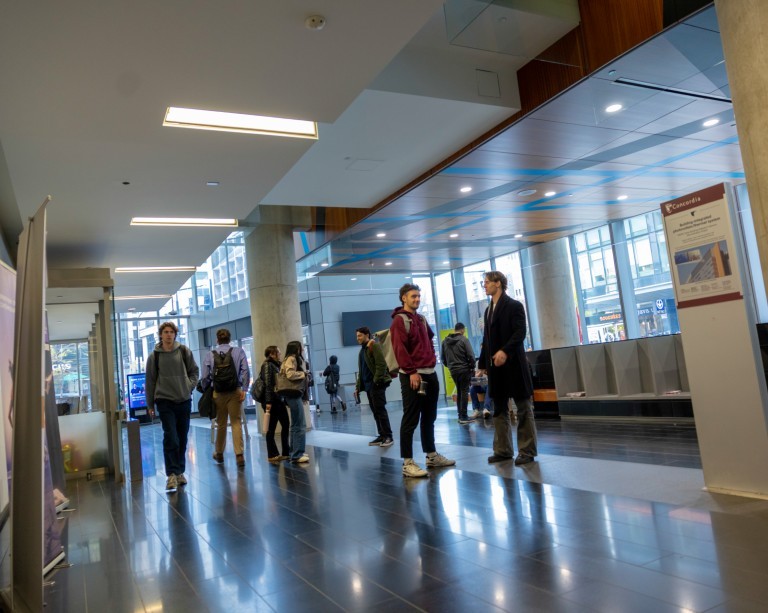Budget updates
Learn more about Concordia’s budget for 2025-26
Last updated: November 12, 2025, 4:07 p.m.
Overview
Concordia is managing a period of deep structural change. In 2025-26, the university will take the next steps in its financial recovery plan — part of a long-term commitment to restore balance and ensure sustainability in a dramatically altered funding environment.
For the first time, overall revenues are projected to decline year over year. At the same time, government funding is not keeping pace with rising costs — and in fact, is decreasing due to policy changes such as the ongoing freeze on operating grants and the acceleration of tuition claw backs. Combined with declining enrolment, particularly among international students, these factors have intensified the financial strain.
Despite the challenges, Concordia remains on track to meet its Fiscal Year (FY) 2024-25 recovery plan target and is continuing to implement the plan approved by the board and the Ministry of Higher Education.
If no additional action is taken, Concordia would be facing a projected $84 million deficit in FY2025-26 — nearly $53 million above the approved $31.1 million in the financial recovery plan. This figure underscores the seriousness of the structural deficit, and the scale of intervention now required.
What’s driving the challenge
Concordia’s structural deficit is the result of multiple, compounding factors:
- The Government of Quebec has announced a two-year freeze on university operating grants, locking institutional funding at FY2024-25 levels despite rising costs.
- In addition, the accelerated claw back from international and rest-of-Canada students has further reduced government funding to universities. This divestment amounts to a loss of $350 million in public funding over the past two years
- Salary increases negotiated under the Government Salary Policy were not matched by the Quebec government, requiring the university to absorb the shortfall.
- Enrolment has declined, particularly among international students — the result of restrictive visa rules by the Canadian government, the Quebec government’s tuition policy changes and other barriers.
- A recent report from the Bureau de coopération interuniversitaire, an organization which unites all Quebec universities on a voluntary basis, estimates that 13 institutions — excluding Concordia and McGill University — will run deficits in 2025-26, with a combined shortfall of $66.4 million. When extended across the full network — including Concordia and McGill — the projected system-wide deficit rises to nearly $134.4 million.
Concordia is especially vulnerable due to its reliance on enrolment and revenues from the rest-of-Canada and international students.
Concordia, along with McGill and Bishop’s University, were also excluded from two grants open to francophone universities supporting international recruitment and the transition to the new funding framework.
Budget strategy and outlook
Concordia is realigning expenditures with actual revenues while protecting its academic and research mission.
The FY2025-26 budget applies a 7.2 per cent cut across all sectors and continues the university’s disciplined approach to financial management.
Expenditure reductions are being implemented across academic, administrative and support areas as part of a multi-year plan to align the operating budget with revenue realities.
What’s already been done
Over the past two years, Concordia has adhered to the financial recovery plan approved by the board and the Quebec government by introducing significant cost-saving measures. The university reduced discretionary spending, began a hiring freeze outside critical academic and operational needs, closed vacant positions, streamlined IT systems, adjusted building services and scaled back or paused certain operations.
These difficult but necessary decisions included:
- A hiring freeze
- Fewer part-time and casual contracts
- Reductions to non-essential travel and use of external consultants
- New cleaning and security schedules
- Reduced shuttle bus hours
- The closing of the Montreal Institute for Genocide and Human Rights Studies
- An exceptional buyout of accrued vacation
- The reduction or suspension of some institutional memberships
In FY2024-25, budget adjustments were set at 3.8 per cent for academic and research sectors, and 8.1 per cent for administrative sectors.
In addition to these operational measures, Concordia implemented structural financial adjustments across corporate portfolios, including:
- Maximizing returns from its sustainable investment policy — supported this year by favourable market conditions
- Reviewing the business delivery model for online learning
- Redesigning the administration of benefits programs, without impacting coverage
- Adjusting pension fund transfers in line with the good financial health of the fund
- Increasing the performance of ancillary operations such as residences, parking and summer camps
While some changes have been unpopular, all have been necessary to maintain the university’s academic and research priorities. Thanks to the extraordinary commitment and adaptability of faculty and staff, Concordia remains on track to meet its recovery plan targets: a $34.5 million in FY2024-25 and $31.6 million in FY2025-26.
Long-term financial recovery
Concordia’s recovery plan, approved by the board and Quebec government in December 2023, runs through FY2028-29. It was designed to restore financial balance through gradual and disciplined action.
While the plan predated many of the current pressures, it remains the most credible strategy and sustainable path forward. Modifying the plan could risk a downgrade to the university’s credit rating and increase borrowing costs, thus adding further pressure to expenses.
To date, including the planned measures for 2025-26, Concordia will have implemented close to $100 million in additional revenues and costs reductions. Based on current trends and available information, an additional $100 million will be required to return to a balanced budget in accordance with the recovery plan.
These actions and initiatives are critical to maintaining the long-term sustainability of the university’s academic and research mission.
Workforce management
Workforce expenditures represent approximately 72 per cent of Concordia’s overall budget and are central to its financial planning.
Key measures include:
- A continued hiring freeze, to be applied more rigorously in FY2025-26
- The closure of an additional 100 staff positions, either currently vacant or opened through regular turnover. This brings the total number of positions closed by Concordia over two years to approximately 200
In addition, the university is actively discussing further initiatives such as:
- Reduced workloads
- Shared services
- Broader use of attrition
- Layoffs, if required to meet targets
While these initiatives are expected to yield medium-to-long term savings, additional short-term measures may still be required before the end of FY2025-26.
Shared effort
These decisions are difficult — and their impacts are real. But they are guided by evidence, made with care, grounded in Concordia’s mission.
Returning to a balanced budget is not just about cost-cutting. It is about establishing a stable, sustainable financial model that allows the university to thrive in the years ahead.
Every step taken — and those still to come — are part of that shared effort.
FAQ
A structural deficit occurs when the university’s recurring expenses exceed its recurring revenues — even before one-time costs or external shocks are factored in. It requires long-term solutions, not temporary fixes.
Between FY2023-24 and FY2028-29, Concordia expects to implement close to $200 million in cumulative cuts to return to a balanced budget.
Yes. While Concordia is working to protect core academic and research activities, some impacts on service levels are unavoidable. Community members may notice changes to how — or how quickly — certain services are delivered.
To address demographic shifts and policy changes affecting enrolment, Concordia is expanding its reach beyond traditional full-time undergraduate and graduate students. The university is exploring flexible delivery models and new global partnerships — particularly in high-demand sectors — to attract a more diverse range of learners without increasing its physical footprint.
Concordia’s financial challenges are not unique. Most Quebec and Canadian universities are facing serious structural financial challenges. Based on the most recent data from the Bureau de coopération interuniversitaire, 13 universities — not including Concordia or McGill — are forecasting operating deficits for 2025-26.
The collective projected shortfall for these 13 universities alone is $66.4 million. If Concordia and McGill are included in the estimate, the sector-wide shortfall climbs to approximately $134.4 million.
Current projections suggest that, without recovery measures, Canadian universities could collectively face a structural deficit of up to $5 billion by 2028.
This confirms that the issue is not isolated — but Concordia is particularly vulnerable due to its reliance on enrolment and revenues from the rest-of-Canada and international students.
Concordia experienced a loss of approximately 700 students in 2024-25 — or 2.3 per cent of its student population. This drop is directly linked to policy changes introduced by both the Canadian and Quebec governments.
At the provincial level, new tuition frameworks significantly increased fees for rest-of-Canada students and altered the funding model for international students. The Canadian government’s caps on international study permits created additional barriers for prospective students.
Concordia was also excluded from two provincial grants open to francophone universities that support the recruitment of international students and the transition to the new funding framework.
These measures have contributed not only to reduced enrolment, but to lasting reputational damage that will take time to repair.
The 2025-26 budget from the Quebec government freezes operating grants for two years, locking institutional funding at 2024-25 levels — despite rising costs across the board. This means:
- Institutional funding will not rise to cover inflation or salary increases.
- Concordia received no additional funding to cover salary increases negotiated under the Government Salary Policy. This gap created a $12 million shortfall that had to be absorbed within existing budgets.
- Provincial funding represents 55.2 per cent of Concordia’s overall budget in FY2025-26. The university’s ability to offset inflationary pressures and salary obligations is therefore significantly limited under the current funding freeze.
- At the same time, the Quebec government has increased the claw back on international tuition revenue. This reduces the effective value of provincial grants — even with a frozen total envelope.
This two-year freeze signals a clear policy of provincial disinvestment in the higher education sector and reinforces the need for structural financial adjustments within the university system.
In FY2024-25, Concordia introduced a range of cost-saving measures aligned with the government- and board-approved financial recovery plan. These include:
- A hiring freeze
- Reductions to part-time and casual contracts
- Lower travel budgets and fewer external consultants
- Streamlined security, cleaning and building service schedules
- Reduced hours for the shuttle bus
- Closure of the Montreal Institute for Genocide and Human Rights Studies
- An exceptional accrued vacation buyout
- Reduction or suspension of certain institutional memberships
Importantly, academic and research units saw a 3.8 per cent cut, while administrative units absorbed an 8.1 per cent reduction.
Structural reforms have also been implemented, including:
- Maximizing returns from Concordia’s sustainable investment policy
- Redesigning the administration of benefits programs, with no impact to coverage
- Adjusting transfers to the pension fund
- Reviewing the business delivery model for online learning
- Increasing the performance of ancillary operations, including residences, parking and summer camps
Concordia is entering a pivotal budget year — with a projected $18.4 million drop in year-over-year revenues. At the same time, the university is managing salary increases, inflation, indexed contracts and other rising costs. After two years of meeting its deficit targets, Concordia must now take even stronger action to stay on track with its financial recovery plan, which runs through FY2028-29.
To manage these pressures, the 2025-26 budget follows this framework:
- Initial projected deficit: $84 million
- Central adjustments: $15.4 million
- Budget adjustments across all sectors: $37.5 million
- Deficit aligned with recovery plan: $31.1 million
Stronger cost controls are being introduced, including:
- A 7.2 per cent budget reduction across all sectors
- A goal to recruit 1,000 additional students, though this is made more difficult by the Quebec government’s Bill 74
- Further developments to streamline operations and explore new revenues
Together, measures already implemented or underway have resulted in additional revenues and cost reductions of $44.4 million in 2024-25, with a further $52.5 million in 2025-26, for a two-year total of $96.9 million in savings and new revenue.
Workforce spending — which represents 72 per cent of the overall budget — remains a central focus. The university is not currently implementing layoffs, but they may be required later in FY2025-26 as a last resort to meet the commitments of the recovery plan.
The following actions are planned or under consideration:
- A hiring freeze will remain in effect and be applied more rigorously in FY2025-26
- The university will close an additional 100 staff positions, resulting in the closure of more than 200 staff positions over two years
- Other initiatives being explored include reduced workloads, shared services, continued use of attrition and a staff Voluntary Retirement Program
While the push to attract 1,000 additional students remains a goal, the focus is shifting toward broadening Concordia’s learner profile. That said, enrolment services and faculties are continuing efforts to stabilize and grow enrolment, particularly at the graduate level, where more flexible intake calendars offer greater opportunity.
Beyond traditional undergraduate and graduate students, Concordia is:
- Diversifying its learner population to reduce reliance on volatile enrolment segments
- Exploring new program models that serve a wider range of learners, including professionals and industry-specific audiences
- Pursuing partnerships with international institutions and sectors, though not through the creation of physical campuses abroad
These efforts are part of a broader institutional strategy to build a more resilient and sustainable enrolment model over the long term.
Salary increases at Concordia are negotiated with unions and associations and are guided in part by Quebec’s Government Salary Policy (GSP), which sets wage parameters across the public sector.
However, the Quebec government does not inform universities how much of the GSP increase it will fund — or when — until well after new agreements are signed. This creates financial uncertainty and often results in a funding gap.
In June 2023, the GSP increase was 6 per cent, but the government funded only 45 per cent of that amount. This left a $6 million shortfall for Concordia — a gap that had to be covered by cutting operational costs. These cuts are recurring and have a lasting impact on the university’s structural finances.
These funding gaps contribute directly to the structural deficit and further limit Concordia’s financial flexibility.
More info
- Download the 2025-26 budget conversations (PDF) June 2025
- Download the 2024-25 and 2025-26 budget conversations (PDF) January 2025
- Download the 2024-25 budget conversations (PDF) June 2024
- Download the 2023-24 budget conversations (PDF) Dec. 2023
- Download the 2023-24 budget presentation (PDF) May 2023




